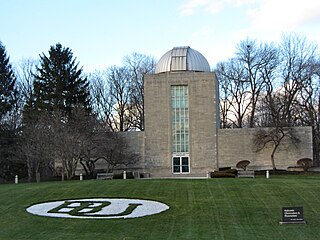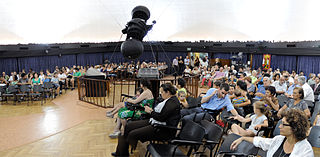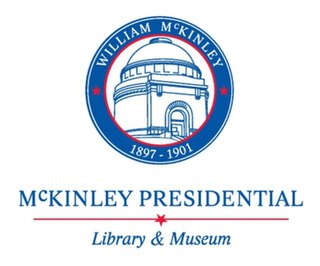Related Research Articles

James Madison University is a public research university in Harrisonburg, Virginia, United States. Founded in 1908, the institution was renamed in 1938 in honor of the fourth president of the United States, James Madison. It has since expanded from its origins as a normal school and teacher's college into a comprehensive university. It is situated in the Shenandoah Valley, just west of Massanutten Mountain.

A planetarium is a theatre built primarily for presenting educational and entertaining shows about astronomy and the night sky, or for training in celestial navigation.

Morehead Planetarium and Science Center is located on the campus of the University of North Carolina at Chapel Hill. As a unit of the university, Morehead receives about one-third of its funding through state sources, one-third through ticket and gift sales, and one-third through gifts and grants.
Evans & Sutherland is an American computer graphics firm founded in 1968 by David Evans and Ivan Sutherland. Its current products are used in digital projection environments like planetariums. Its simulation business, which it sold to Rockwell Collins, sold products that were used primarily by the military and large industrial firms for training and simulation.

The London Planetarium building is located on Marylebone Road, London. It is adjacent to and owned by Madame Tussauds. It previously housed a planetarium, offering shows related to space and astronomy. In 2006, it was closed as a separate attraction and became part of Madame Tussauds. Since 2010, the building that previously housed the London Planetarium had a Marvel Super Heroes 4D attraction.

The Roger B. Chaffee Planetarium, named for astronaut Roger B. Chaffee, was constructed in the early 1960s as part of the Public Museum of Grand Rapids. The facility initially featured a 30-foot (9.1 m) plaster dome and a Goto Optics mechanical star projector. Among the planetarium's first shows was "Star of Wonder", an astronomical attempt at an explanation of the Star of Bethlehem. The show received positive reviews in the Grand Rapids area and remained in the Chaffee's catalogue for several years.

The Clark Planetarium is a planetarium and science museum situated within The Gateway at the intersection of 400 West and 100 South in downtown Salt Lake City, Utah, United States. The Clark Planetarium opened in April 2003, replacing the historic Hansen Planetarium under a grant from the Clark Foundation in cooperation with Salt Lake County.

The Fleet Science Center is a science museum and planetarium in Balboa Park in San Diego, California. Established in 1973, it was the first science museum to combine interactive science exhibits with a planetarium and an IMAX Dome (OMNIMAX) theater, setting the standard that most major science museums follow today. It is located at the east end of the El Prado Drive walkway, next to the Bea Evenson Fountain and plaza in central Balboa Park.
UNA Observatory is an astronomical observatory owned and operated by the University of North Alabama. It is located in Florence, Alabama (USA). It has 2 telescopes, a Celestron 0.35 m Schmidt–Cassegrain telescope. The UNA Planetarium is a 65-seat planetarium with a Spitz A3P projector and East Cost Control Systems controller.

Armagh Planetarium is a planetarium in Armagh, Northern Ireland. It is located close to the city centre and neighbouring Armagh Observatory in approximately fourteen acres of landscaped grounds known as the Armagh Astropark.

A planetarium projector, also known as a star projector, is a device used to project images of celestial objects onto the dome in a planetarium.
Digistar is the first computer graphics-based planetarium projection and content system. It was designed by Evans & Sutherland and released in 1983. The technology originally focused on accurate and high quality display of stars, including for the first time showing stars from points of view other than Earth's surface, travelling through the stars, and accurately showing celestial bodies from different times in the past and future. Beginning with the Digistar 3 the system now projects full-dome video.

Holcomb Observatory and Planetarium is a part of Butler University in Indianapolis, Indiana.

Armand Neustadter Spitz was an American planetarium designer.

The Nantes Planetarium is a public planetarium that opened on 18 June 1981. It operates as an auditorium that presents astronomy shows for all audiences.

B. M. Birla Planetarium is a large planetarium in Chennai, India. The fifth B. M. Birla planetarium in the country, it is located at Kotturpuram in the Periyar Science and Technology Centre campus which houses eight galleries, namely, Physical Science, Electronics and Communication, Energy, Life Science, Innovation, Transport, International Dolls and Children and Materials Science, with over 500 exhibits. Built in 1988 in the memory of the great industrialist and visionary of India B. M. Birla, it is considered the most modern planetarium in India, providing a virtual tour of the night sky and holding cosmic shows on a specially perforated hemispherical aluminium inner dome. Other Birla planetariums in India include the M. P. Birla Planetarium in Kolkata, the Birla Planetarium in Hyderabad, and the planetariums in Tiruchirapalli and Coimbatore.

Abrams Planetarium is the planetarium on the campus of Michigan State University, Michigan, United States.

The William McKinley Presidential Library and Museum is the presidential library of 25th U.S. president William McKinley. The library, which is located at the foot of the McKinley National Memorial, is owned and operated by the Stark County Historical Society, and located in Canton, Ohio, where McKinley built his career as lawyer, prosecuting attorney, congressman, governor and president.

The Professor Aristóteles Orsini Planetarium, also known as the Ibirapuera Planetarium, is a planetarium in Ibirapuera Park, São Paulo. It opened in January 1957, and was the first planetarium in Brazil and Latin America. It is one of three planetaria in São Paulo, with the others being Carmo Planetarium and the Johannes Kepler Planetarium at Sabina Escola Parque do Conhecimento.

The University of Washington Planetarium is an active planetarium located in the Physics/Astronomy Auditorium on the University of Washington campus in Seattle, WA. The dome is 30 feet in diameter and utilizes six digital projectors to create an interactive display using the Worldwide Telescope planetarium software.
References
- 1 2 3 4 5 6 James Madison University Physics Department (1979). The James Madison University Planetarium. Print, retrieved from the James Madison University Archives
- ↑ "Visiting the John C. Wells Planetarium". James Madison University. 2015.
- ↑ "James Madison University:John C. Wells Planetarium". www.jmu.edu. Retrieved January 19, 2016.